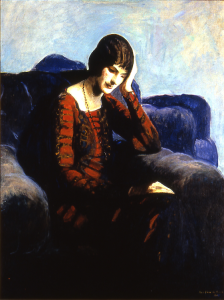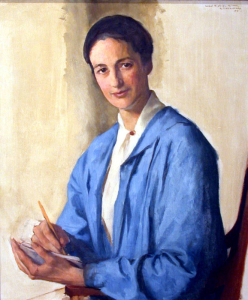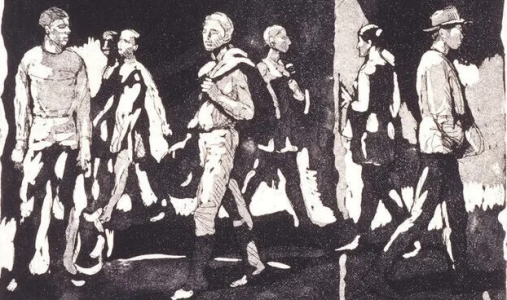

Biography
Isabel Bishop's parents were well-educated and used to an upper class existence. Her mother was a suffragist and feminist who want to write. Her father knew Latin and Greek and had successive jobs teaching and managing in schools. Their attempt to found a prep school in Princeton was not successful financially, and they moved to Cincinnati, OH, where Isabel was born. She had four siblings - two sets of twins, both more than ten older than she was. From Cincinnati the family moved on to Detroit, MI, where Isabel grew up. It was a lonely existence: her mother was emotionally distant, and the parents' upper class pretensions made them discourage Isabel from interacting with other children in their lower class part of Detroit.
At age 12 Isabel began to attend Saturday morning life drawing classes at the John Wicker Art School. Unusually, Wicker had the children draw from nude models - Isabel's first introduction to this art form, but one she would never abandon. In 1918 Isabel graduated from high school (at age 15) and continued her art studies with John Wicker. Her father's benevolent cousin, James Bishop Ford, recognized Isabel unusual dedication to art and funded her move to New York, where she enrolled in the New York School of Applied Design for Women, expecting to be trained as an illustrator.
But these were heady times in the New York art world, and Isabel was swept up in the enthusiasm for French painting. Within two years, she abandoned the idea of a commercial career and enrolled at the Art Students League, where she studied from 1921-1924. Initially she worked with the cubist Max Weber, but this proved to be a poor fit, and she moved to study with Kenneth Hayes Miller. Later she studied with Guy Pène du Bois and Robert Henri. Isabel also became friends with fellow students Edwin Dickinson and Reginald Marsh.
Brief museum trips to Europe gave Bishop an acquaintance with Dutch and Flemish painters and helped her develop her own particular style of painting. Simply put, she sought to apply the techniques and manners of the old masters to capture elements of the contemporary scene. Over time she developed elaborate methods of creating her paintings, such that she could only produce one or two finished works a year.
The approach that Bishop evolved started with drawings. The drawings would then be refined into etchings, with many possibilities being rejected in the process. From those drawings that survived as etchings, Bishop would select topics that she would develop further, often with a complex combination of tempera and oil paint.
Bishop did her first etching in 1925. And in 1926 she created a studio in Union Square, where she would remain for most of her creative life. The realist style that Bishop prefered was a key element of the paintings of her teacher Kenneth Hayes Miller and her friend and fellow student, Reginald Marsh. Together with Raphael Soyer, this trio came to be known as the "Fourteenth Street School." These artists sought gravitas from the masters of the Renaissance and Baroque, particularly Michelangelo, Peter Paul Rubens and Rembrandt, while choosing their subjects from everyday Americans, whether the working poor or the emerging middle class.
Bishop first exhibited at the Dudensing Gallery in New York in 1930. She participated in the art event at the 1932 Summer Olympics. And in 1932 she began showing at the newly-opened Midtown Galleries, which featured her work for years to come. She married the neurologist Harold G. Wolff in 1934, and the couple moved to Riverdale, NY, but she maintained a studio in Union Square, typically working there seven days a week, until 1984. Her art was included in the Whitney Biennials in 1932, 1934 and 1936 - and in ten subsequent annual exhibitions at the Whitney. Her painting "Two Girls" was purchased by the Metropolitan Museum of Art in 1936. In keeping with her focus on ordinary working people, the subjects of that painting were a waitress from Childs Cafeteria and her friend.
Bishop taught at the Art Students League in 1936-1937, but she viewed teaching as an unwanted distraction from her full-time focus on painting. She received a commission to paint the New Lexington, OH Post Office mural "Great Men Came from the Hills" in 1938. The subject was a compressed history of the town of New Lexington, inspired by her visit to the town and her discussions with local historians. In 1940 Bishop was elected as an Associate Member of the National Academy of Design, becoming a Full Member in 1941. She exhibited at the New York World's Fair in 1940 and won first prize from the American Society of Graphic Artists the same year.
Bishop studied with the printmaker Stanley William Hayter, and in 1943 she enrolled in his engraving class at the New School. However, she continued to prefer etching, with its speed and portability. In 1946 Bishop became the Vice President of the National Institute of Arts and Letters (their first woman officer), where she particularly enjoyed her interactions with recognized writers.
As Abstract Expressionism rolled across the art world in the 1950s, Bishop, Raphael Soyer and the whole panoply of realist artists gathered to produce a short-lived, but influential, journal entitled Reality: A Journal of Artists' Opinions.
Bishop taught at the Skowhegan School of Painting and Sculpture from 1956-1958 and again in 1963. In the 1960s her focus shifted from individuals from the working class to a theme of pedestrian movement. She expanded her technical repertoire by introducing aquatint into her prints, enjoying the accidental effects the method sometimes produced.
Bishop was the recipient of many awards and prizes, including the National Arts Club gold medal (1968, 1970), the Mount Holyoke College Art Museum purchase prize (1974), the Brandeis University Creative Art Award medal (1975), the award for Outstanding Achievement in the Arts (1979), and the American Academy and Institute of Arts and Letters gold medal for painting (1987). Until illness forced her retirement in 1984, she continued to work in her Union Square studio. She died in Riverdale, NY in 1988.


Critical Analysis
Isabel Bishop had a mission, first inspired by the teaching of Kenneth Hayes Miller, and refined by her studies of Renaissance and Baroque art and her investigations into the work of Rembrandt van Rijn and Peter Paul Rubens. She once said "Everything I have tried to do is Baroque." Her palette was limited by choice. As she put it, "Color is not an original motif for me. My fundamentals are form, space and light.
Bishop's work went through two distinct phases. For years she would sketch the street scene at Union Square or go underground to draw people in New York's subways. The resulting paintings often focused on the "New Woman," someone who was emerging from a working class family and seeking upward mobility, but was typically engaged as a shop girl, waitress or clerk. Thus, while Bishop's painting technique was firmly tethered to the methods of the old masters, her subject matter was taken from the streets and shops of New York.
After 1960 Bishop became more and more interested in the idea of motion, and many of her paintings featured strolling pedestrians. Her studio must have been quite a sight - with one or two models walking about endlessly, jackets flung over their shoulders or parcels burdening their arms.
Throughout her career Bishop would also paint nudes. This could have been a throwback to her first experience or art in the John Wicker School at age 12. But she found the nude a refreshing subject. And, typically, while her models posed in stationary positions, she made an effort to represent the potential of movement in her portrayals of these models.
Murals
- New Lexington, Ohio - Post Office: Great Men Came From the Hills
References
- Kelli Fisher, Celebrating the ‘Unheroic’: Women Walking in a Subway Station by Isabel Bishop, Everson Museum of Art March 4 (2022).
- Marlene Steele, Celebrating the Modern Woman: Isabel Bishop 1902-1988, AEQAI May (2020).
- A Finding Aid to the Isabel Bishop Papers, 1914-1983 (Smithsonian Online Virtual Archives).
- Isabel Bishop (Wikipedia).
- Isabel Bishop (Smithsonian American Art Museum).
- Isabel Bishop (DC Moore Gallery).
- Isabel Bishop (SPQR Fine Art).
- Isabel Bishop (Woo Arts).
- Isabel Bishop (Caldwell Gallery Hudson).
- Isabel Bishop (Terra Foundation for American Art).
- Isabel Bishop (Encyclopedia.com).
- Ellen Moody, Isabel Bishop (1902-1988): “And that was my first walking picture”, Reveries Under the Sign of Austen November 9 (2015).
- Isabel Bishop papers, 1914-1983 (Archives of American Art).
- Summary of Fourteenth Street School (The Art Story).